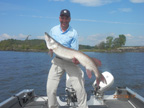
Posts: 3508
Location: Elk River, Minnesota | Hi Bret,
What moving the motor up will do is primarily get more lower unit out of the water. By doing so, you are getting an end result of less water resistance, which in turn means the prop has an easier time moving the boat forward in the water. When this happens, your RPM's will go up (roughly 100 RPM's a hole). What probably is also happening is the boat will usually ride a little higher while at speed as well. What is interesting on this is that on many walleye boats (Deep V hulls) the motor with a steel prop is at it's most efficient placement when the anti-ventilation plate is anywhere from 2 to 2-1/2 inches ABOVE the lowest point on the hull. Reason for it is as soon as the boat goes by the gap between the boat and the motor starts to fill up with water.
Now there is a trade off though (or maybe better stated a limit to what can take place)...the higher you move the motor, the less handling ability the boat will have....usually showing itself on moderate turns. A good rule to follow is move the motor up to the third hole and test. If the prop slips (motor revs up and loses it's bite) on a moderate turn, move the motor down one hole and you are as good as you can get with the particular prop you have. A steel prop will hold the water much better sinc the blades are usually cupped, and thinner so it has less flex. this also means better thrust since the stated pitch of the prop is much closer under load than with aluminum props.
Anytime you switch to a steel prop of the same pitch and diameter, you will see a reduction in RPM's...roughly about what you stated. Move the motor up and you may be extremely happy with the result.
As far as trimming up, that might be a characteristic of the boat which does not allow upward trim well...and there are tricks to help that. I know on my navigator, I am able to trim up to about 3/4 of the way on the trim gauge at full throttle on a straight line shot. To be honest, I don't think that is all that uncommon. I trim until the bow of the boat starts to porpoise or RPM's go up without a gain in speed, then back off just a touch to settle things down.
I say experiment!! Move the motor to it's highest position on the transom and see how it goes.
If you are still finding the bow not coming up (I am guessing that might be the case) let me know....I've got a trick for that, but it is a fine line, so little adjustments and testing is the rule...
By the way...you will not have to worry about losing water pressure so long as you stay within the bolt holes on the motor. Those boats which have a set-back or jackplate on them can potentially raise the motor too high which would allow too much air to get in, thus losing water pressure.
Steve
Edited by VMS 1/21/2009 8:09 PM
|





